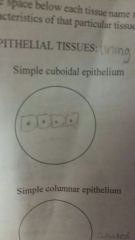![]()
![]()
![]()
Use LEFT and RIGHT arrow keys to navigate between flashcards;
Use UP and DOWN arrow keys to flip the card;
H to show hint;
A reads text to speech;
20 Cards in this Set
- Front
- Back
|
Epithelial Tissue |
Lining & coverings; some glandular - simple/stratufied/pseudostratified - Cubodial/columnar/squamos |
|
|
Cubodial |
Cubed; like dice • equal width, length, & depth
|
|
|
Columnar |
Finger-like; tall & thin |
|
|
Squamos |
Fried egg (side view) |
|
|
Stratified |
More than one layer thick |
|
|
Simple |
1 layer thick |
|

Simple Cubodial Epithelium |
Function: secretion & absorption Location: kidney tubules; ducts & secretory portions of small glands; ovary surface |
|
|
Pseudostratified Columnar Epithelium |
Function: secrete substances, particularly mucus; propulsion of mucus by ciliary action Location: nonciliated - males' sperm-carrying ducts of large glands Ciliated - traches; most of the upper respiratory tract |
|
|
Simple Columnar Epithelium |
Function: absorption; secretion of mucus, enzymes, & other substances -- ciliated type: propel mucus by ciliary action Location: nonciliated type- lines most of the digestive tract, gallbladder, & excretory ducts of some glands Ciliated type- lines small bronchi, uterine tubes, and some regions of uterus |
|
|
Stratified Squamous Epithelium |
Skin; the boring looking one Function: protects underlying tissues from abrasion Location: nonkeratinized type- forms the moist lining of the esophagus, mouth, & vagina Keratinized type- forms the epidermis of the skin, a dry membrane |
|
|
Connective Tissue |
Varied - structure, support & function - areolar - adipose - hyaline - bone |
|
|
Areolar Connective Tissue |
Looks like broken glass or spider web Function: wraps & cushions organs; its macrophages phagocytize bacteria; plays important role in inflammation; fights infection Location: widely distributed under epithelia of body; packages organs; surrounds capillaries below skin |
|
|
Adipose Tissue |
Looks like marshmallows Function: provides reserve food fuel; insulates against heat loss; supports & protects organs Location: under skin in the hypodermis; around kidneys & eyeballs; within abdomen; in breasts |
|
|
Hyaline Cartilage |
Looks like bugs; chondocyte = cartilage cell Function: supports & reinforces; has resilient cushioning properties; resists compressive stress Location: forms most of embryonic skeleton; covers the ends of long bones in joint cavities; forms costal cartilages of the ribs; cartilages of the nose, trachea, & larynx |
|
|
Bone |
Looks like tree stumps; osteocytes = bone cells Function: supports & protects (by enclosing); provides levers for the muscles to act on; stores calcium, minerals, & fat; marrow inside bones is the site for blood cell information |
|
|
Muscle Tissue |
All produce force - skeletal - cardiac - smooth |
|
|
Skeletal Muscle Tissue |
Looks like straight lines Functions: voluntary movement, locomotion; manipulation of the environment; facial expression Location: in skeletal muscles attached to bones or occasionally skin |
|
|
Cardiac Muscle |
Looks like branches Function: as it contacts, it propels blood into the circulation; involuntary Location: walls of the heart Interculated disks |
|
|
Smooth Muscle |
Function: propels substances or objects (urine, food, fetus) along internal passage ways; involuntary Location: mostly in the walls of hollow organs |
|
|
Nervous Tissue |
Neurons Function: transmits electrical signals from sensory receptors & to effector (muscles & glands)which control their activity Location: brain, spinal cord, nerves |

